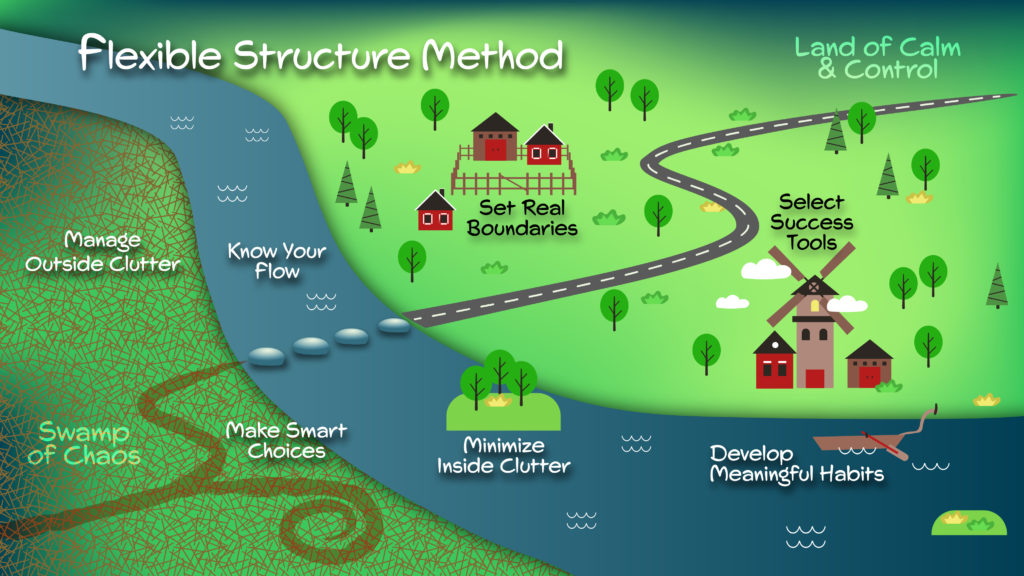 Ever feel like the organized and productive people that you know understand a language that you don’t speak? You ask questions about how they are able to find their stuff or complete their tasks and you’re baffled by their response. After all, you’ve tried some of the same tactics without any success and you’re frustrated!
Ever feel like the organized and productive people that you know understand a language that you don’t speak? You ask questions about how they are able to find their stuff or complete their tasks and you’re baffled by their response. After all, you’ve tried some of the same tactics without any success and you’re frustrated!
This is one reason why I created the Flexible Structure Method. It’s time that there was a simple way for people to find productivity and organizing techniques that will work for their specific situation.
WHAT IS THE FLEXIBLE STRUCTURE METHOD?
The Flexible Structure Method (FSM) is a proven technique to facilitate organization and productivity with lasting results. The seven components of this method are based on the idea that you desire organization to provide structure in your current environments. You also want to be productive so you can easily knock tasks off your list. Yet you need the flexibility to easily modify these systems as your personal or professional life changes.
WHAT MAKES FSM DIFFERENT FROM OTHER ORGANIZING OR PRODUCTIVITY METHODS?
The Flexible Structure Method accounts for the fact that getting or staying organized isn’t a black-and-white process that can be achieved in distinct steps. It is more of a “gray” process with a language all its own. If you aren’t “naturally organized,” getting organized in a way that matters to you and your lifestyle requires learning, action, and maintenance. This doesn’t mean that organizing is unattainable or something to fear. It’s simply an indication that you need a meaningful framework to develop your “organizing muscles.”
It’s the same with productivity. It’s not a one-size-fits-all situation in which you follow five steps then you always complete your tasks. Instead, there are many factors to account for, when tackling your professional and personal tasks. Sometimes these factors change, so you have to shift too.
It’s never too late to learn the language of organizing and productivity, and use it with family, colleagues, or friends.
If you’ve recently been diagnosed with an autoimmune disease or you’re an empty-nester whose ADHD is impacting you differently than it used to, you can master the Flexible Structure Method. Whether you’re a CEO, manager, or have other duties at work, you can acquire the knowledge as well, regardless of your diagnosis.
What makes my approach so different? I take words you’re familiar with and give them a new context. It is all based on my proprietary method of organizing and productivity. Here’s a brief, high-level overview:
Boundaries: are set for the amount of space you allow for categories of stuff or the quantity of time allotted for tasks. Learn more about boundaries.
Choices: are made around whether or not you stick to your boundaries. Choices are also made about your acquisition of new stuff, information or tasks. Learn more about choices. Link coming soon!
Habits: are developed around what you do with new stuff, data, or tasks when it enters your space. You already have habits, yet they might not be serving you well. Learn more about habits. Link coming soon!
Outside Clutter: is managed when you decrease or eliminate the source of external clutter in your space, schedule, or files. If the origin of clutter is homeless items, then creating a home for your information, tasks, or stuff is your first step. If limitations (space or skill set) are the source of the clutter, then increasing these is usually the answer. There are additional sources of outside clutter too. Learn more about outside clutter. Link coming soon!
Inside Clutter: is minimized when you are able to quiet the brain chatter* that tells you that a deal is “too good to pass up” or that you’re tired and will “process the mail tomorrow” or that you don’t need to unsubscribe to e-newsletters because you’ll “read them sometime”. You may need to conquer a fear (i.e. about needing an item once it’s deleted), gain new clarity (i.e. around your organizing or productivity goals), or unlearn a long-standing behavior (i.e. move from a standard perfection to excellence). Learn more about inside clutter.
Flow: is known when you have established ways for your stuff, information, and tasks to flow into and out of your space or your schedule. Most people are great at having stuff, data and tasks flow in but aren’t sure how to make them flow out. Without having equal “outflow” and “inflow,” you are likely to experience overwhelm. Learn more about flow.
Tools: are selected according to your current needs but with an eye toward the future when circumstance may change and you want to be able to take these tools and re-purpose them. There are three types of tools:
- Supplies: storage related items, including boxes, bins, and shelving; calendar, productivity apps, etc.
- Skills: decision-making, deleting, delegating and other skills which are critical for being organized and productive
- Support: other people such as family, friends, therapists, coaches, organizing and productivity professionals who can assist with parts of the process that are more difficult for you.
Learn more about tools. Link coming soon!
Because the Flexible Structure Method is robust, it’s best to learn and implement it in stages.
